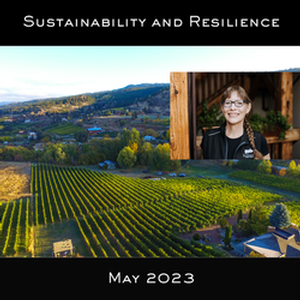As we celebrate budbreak, that magical period when the grapevine buds come out of dormancy, reconnect with the vine’s vascular system to draw up the nutrients stored in the root system through the winter, and unfurl two tiny leaves and a teeny pre-grape cluster, we wonder what the season will bring us. Each growing season is different which forces us to be ready to quickly pivot and adapt to new conditions. Here in the Okanagan we are at the edge of viability for grapevines and need to continually tweak our growing practices to ensure winter hardiness as well as full-ripening. Faced with global climate change this need becomes urgent and resilience and sustainability are key.
How do we meet these challenges? In 2011 the BC Wine Grape Council, the organization funded through a mandatory levy on wine grapes harvested and led by a group of volunteer winemakers and growers, created Sustainable Winegrowing BC (SWBC). Drawing on examples from wine regions around the world but adapting to the specific needs and challenges of BC, they created a sustainability self-assessment program so the vineyards and wineries could gauge how they measure up in terms of sustainability-environmental, social, and commercial-and gauge their improvement over time. December blog
In 2019 SWBC created an audited certification so that vineyards and wineries could communicate their commitment to sustainability. Led by Tightrope Winery on the Naramata Bench, 13 BC wineries now have achieved SWBC certification.
One of the requirements for winery certification is that a large percentage of the fruit come from certified vineyards. I have a close relationship with the folks who manage our contracted vineyards so I know that they have good practices and will pass an audit, but the first certification can be daunting as record-keeping is key. Growers keep records out of necessity, but it isn’t always pretty—personal diaries, shoeboxes containing notes on backs of envelopes etc. We needed to give them support and confidence to get them over that hurdle.
Through February this year SWBC and I met with a group of our growers weekly (after their pruning day was done) to work through self-assessment challenges and prepare for their audits. Each week the meeting ended with long discussions about vineyards, past present and future. It was a brilliant way to connect the growers and create a dynamic trade of information, ultimately contributing to sustainability.
Last month Gjoa’s Vineyard (of merlot fame) became our first grower to receive SWBC certification. Yayayay! We expect to celebrate more such achievements soon.
What about resilience? The last few years have presented us with new challenges in the vineyard. The heat dome at the end of June 2021 (Naramata Bench saw 44° C), a situation never before seen especially at that point in the growing season, and the extreme cold this past December (-27°C in Oliver and Kelowna, -24° here on the Bench) can both be attributed to our changing climate.
The BC Ministry of Agriculture has recognized these challenges and is working with all perennial fruit and nut crop organizations to establish replant programs should widespread plant death become evident.
Again, because our growing area is unique in the world, we have to take the initiative to adapt to these changes without the benefit of information from afar. This presentation, How climate change reshapes terroir by UBC researcher Dr. Elizabeth Wolkovich, outlines how other regions are experimenting with different grape varieties, but also why we need to conduct our own trials. While we can predict how a new variety will do here based on our temperature ranges, soils, and growing degree days, many of the vines’ functions are determined by less-understood triggers such as daylight hours etc. So you although you might predict that a variety that does well on a Greek island would flourish here at 44° C, without planting and trialling it here, you cannot know for sure.
Most wine regions of the world use only a few varieties for wine—maybe 20 to 30, but Spain, Italy and Greece have been growing and making wine from hundreds of different varieties for centuries. In order to explore the suitability of some of these for the Okanagan, we need to establish a network of small vineyard blocks (as few as 20 plants) and plant trial vines of many many varieties from hotter climes to inform our planting decisions of the future. Winemakers and consumers need to be open to experiencing new varieties for this region—super exciting times!
